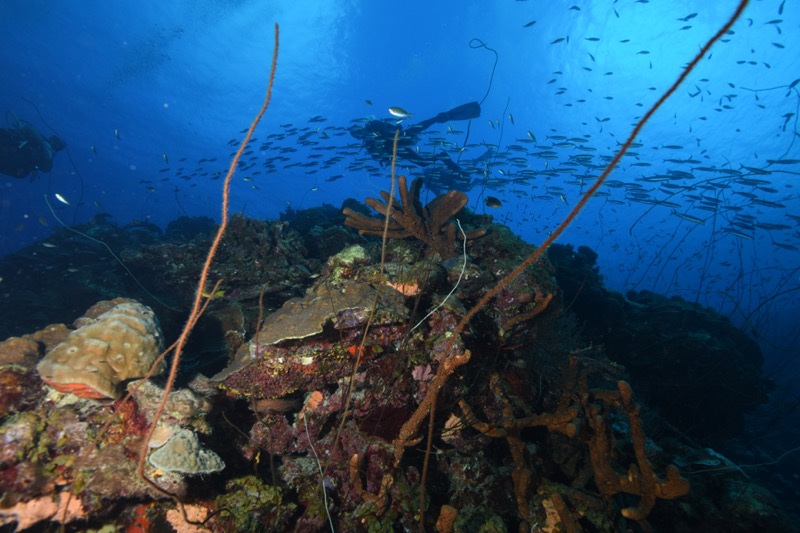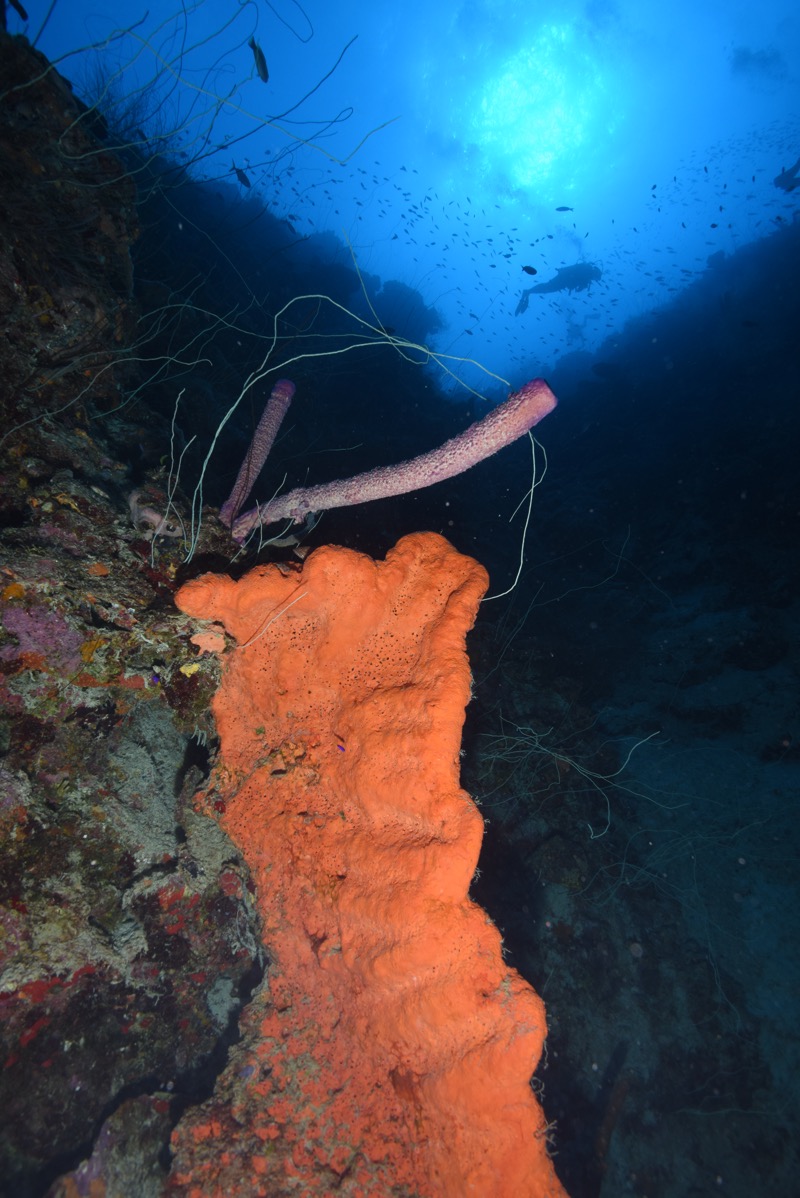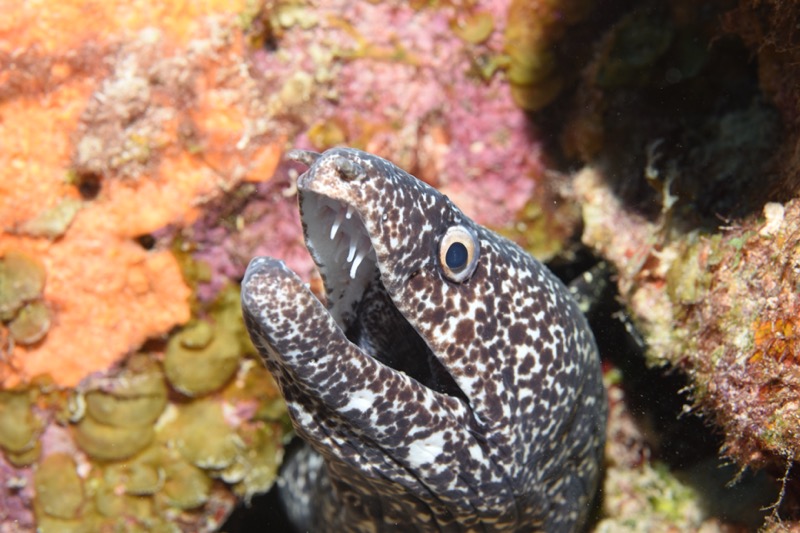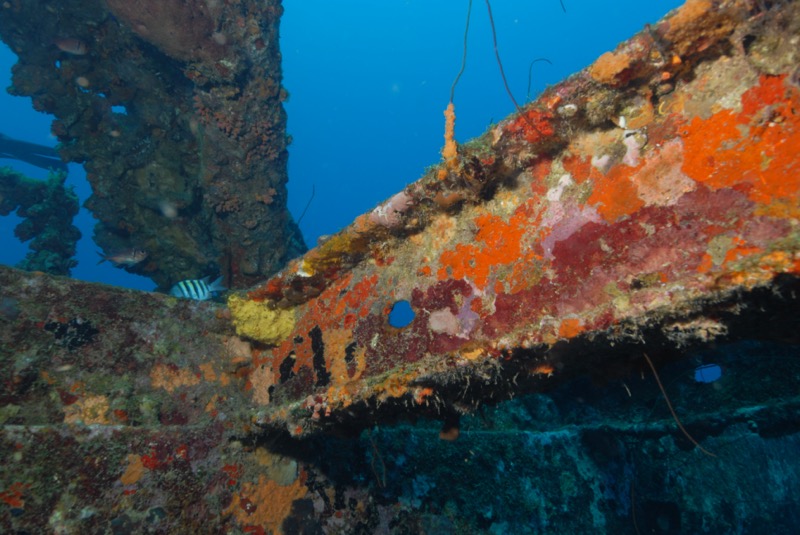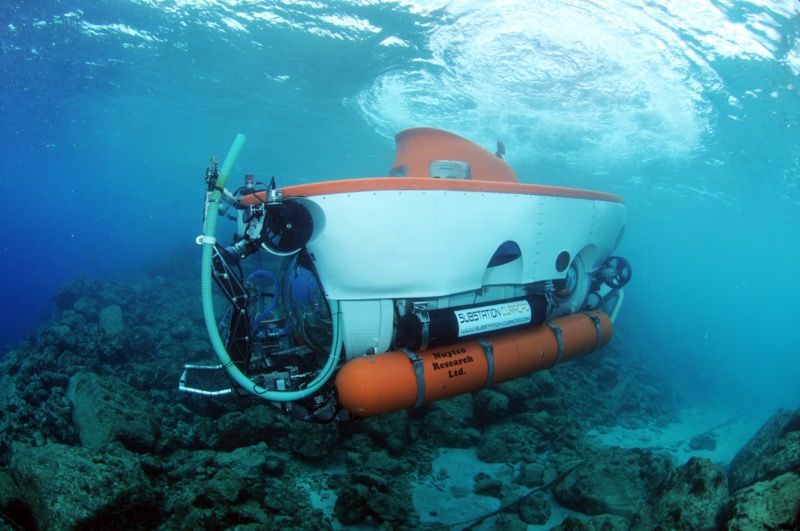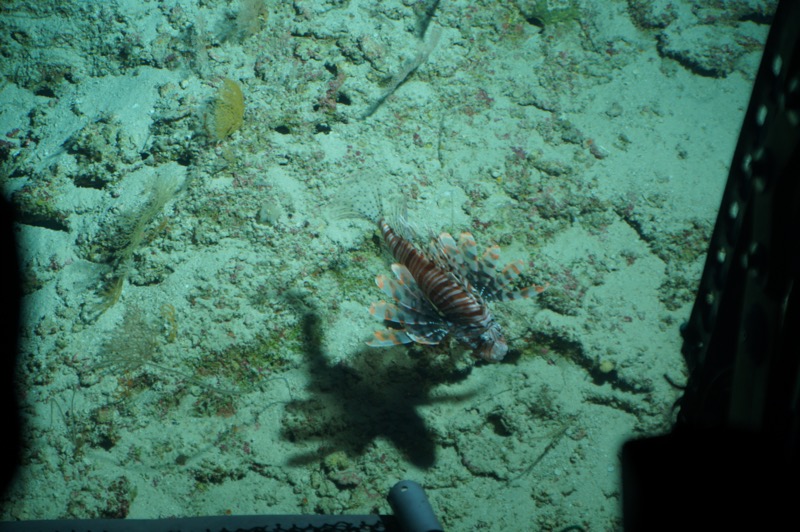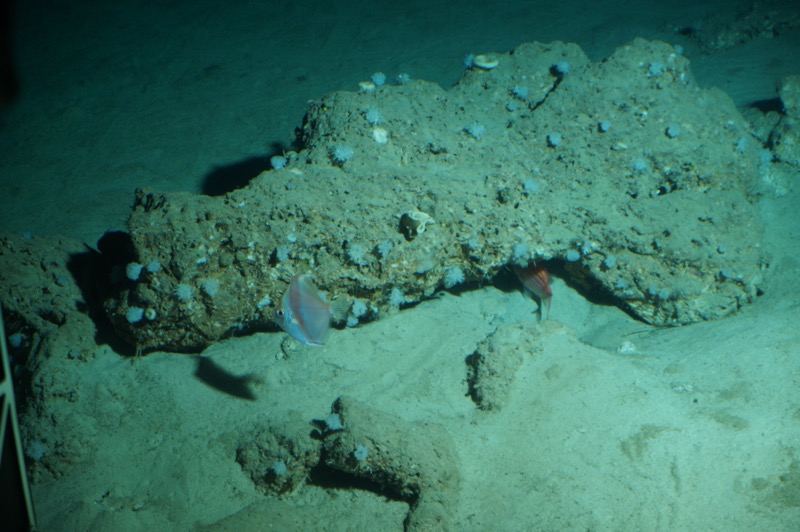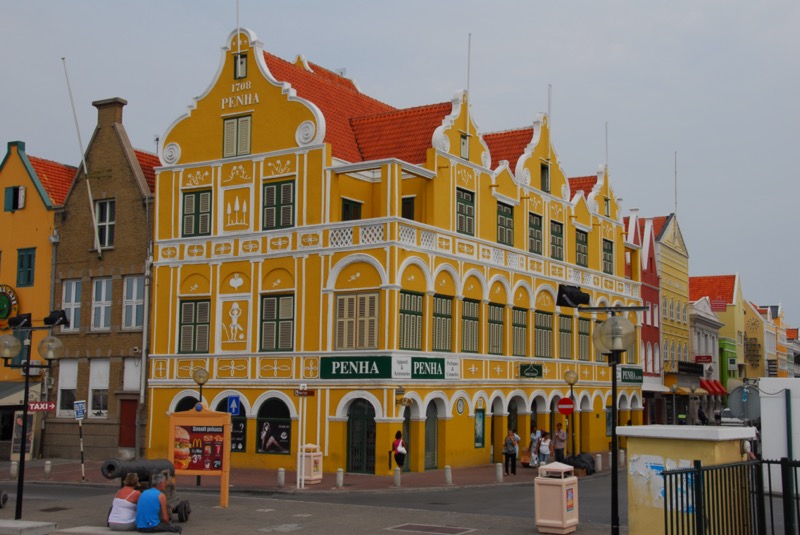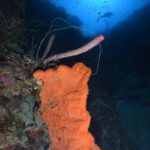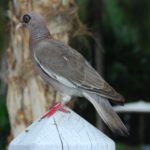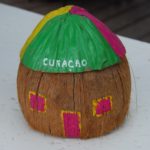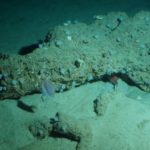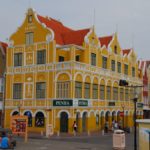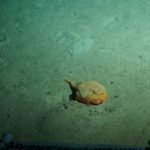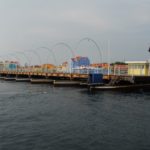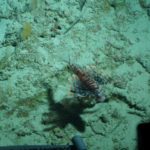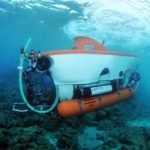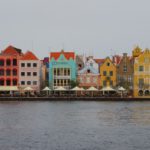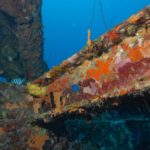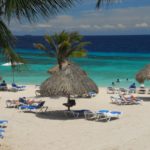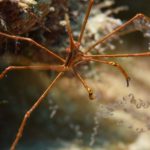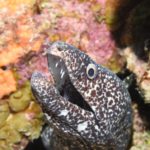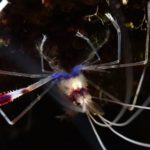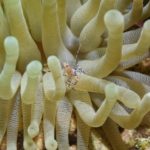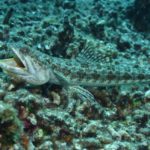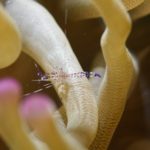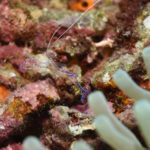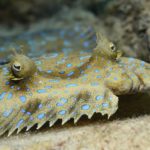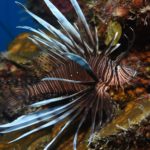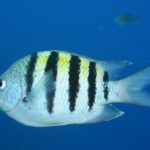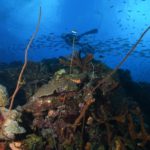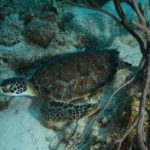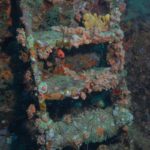The reef dropped off suddenly and tumbled into the depths, creating a sheer wall beginning at 45 feet and extending beyond recreational diving limits. Hard corals mixed with colorful sponges made for an inviting journey along the reef wall. Schools of wrasse and tang darted about, while several wary Moray Eels poked their heads out of crevices to strike a threatening pose. This was Blue Bay Wall in Curacao, our first dive of the week, and a good start for our theme of the trip: to explore Curaçao’s deeper reefs and eventually to journey deeper than most SCUBA divers ever get to dive!
Words & Photos by Michael Salvarezza & Christopher P. Weaver
Curacao is the “C” in the ABC islands of Aruba, Bonaire and Curacao. It lies just 35 miles north of Venezuela and itself is just 37 miles long and 7 miles wide. In sharp contrast to the coral jungle that lies just offshore beneath the waves of the warm Caribbean Sea, Curacao features an arid, desert like landscape. Indeed, only about 21 inches of rain falls per year. The stingy amount of rainfall combined with hot and sultry temperatures gives rise to cactus and other desert flora and fauna. It also means very little runoff from the land, making for invitingly clear waters.
As we traversed Blue Bay Wall, we found ourselves swimming with Nassau Grouper, Rock Hind and several species of Parrotfish. With a water temperature of 85 degrees, we were quite comfortable in our 3mm suits for an extended exploration.
Blue Bay Wall is one of Curacao’s best dives but there are many others to keep divers visiting this Dutch territory intrigued. In short order, we fell into a pleasant routine of diving twice in the morning, grabbing a hearty island lunch and either spending the afternoon doing another dive, enjoying time on the beach or getting out and about on the island. During our stay, we explored a number of quality dive sites, but the best four that we visited are described below.
At a site known as Playa Largo Drift, we cruised over a picturesque reef system in a slight current. Here we photographed Lizardfish and a Peacock Flounder along with myriad invertebrates such as Feather Duster and Christmas Tree Worms. This was a good second dive of the day because its reef system was shallower than the deeper walls. The “drift” in the name is a bit misleading though. You might think this would be a dive in a strong current but really it was just a gentle flow along the shore.
In Bullen Bay, we dropped to 75 feet and spotted a Green Moray as well as a Giant Barracuda patrolling the reef. This site also features a wall and drop-off, and smart divers keep one eye focused on the deep blue waters away from the reef to spot Jack, Tuna and the occasional Reef shark.
One of Curacao’s signature dives is called Mushroom Forest. This is a favorite spot known for its huge coral growths and columns of rock covered in Orange Cup Corals. The “garden” extends over a large swath of ocean bottom and the outcroppings resemble large mushrooms. We did not have the opportunity to do a night dive here but we imagine the Orange Cup Corals would make for striking photographs in the dark of night.
Curacao’s dive sites include some fascinating shipwrecks. For example, at the mouth of Willemstad Harbor is the wreck of the Superior Producer. This was a freighter that sank in 1977 in 100 feet of water. When we visit the Caribbean, its often hard to imagine ships sinking in the calm, clear, warm waters of these tropical seas. But water is water, and bad judgement and poor seamanship can sink a vessel here just as easily as anywhere else in the world.
The Superior Producer had been overloaded when it left port against the advice of its captain, whose trepidation became reality almost before the crew had finished waving good-bye to the people on the shore. The 240-foot cargo ship was headed for Venezuela for the Christmas shopping season and her hold was filled at the time with clothes and alcohol. But the water was rough and the combination of large ocean swells and too much cargo spelled immediate trouble for the vessel. In only a few minutes, the ship’s cargo shifted in the ocean swells, and the Superior Producer sank quickly and on an even keel.
Shortly after the sinking, blue jeans, cotton T-shirts, sheets and crates of whisky began to wash up on shore. That cargo turned into a gift to the local population and even local divers got into the act in their “rescue” efforts “recovering” the cargo! In just a few days, many people on the island were dressed in new clothes and many others were drunk from the new-found whiskey!
Today the wreck continues to be a gift to Curacao as a terrific dive. The wreck is covered with marine growth and is home to a wide variety of fish life. We found some purple-tipped anemones near the base of the wreck and, upon closer examination, saw that they were home to several species of colorful shrimp. For true wreck divers, there is some minor penetration possible into the bridge area and down into some of the cargo holds.
As much as we were enjoying Curacao’s deeper reefs and walls, the main purpose of visiting this island was to grab the opportunity to dive deeper than we could ever hope to go on SCUBA. This would be done through the use of a submersible. Substation Curacao, located near the Curacao Aquarium, takes passengers on an exhilarating dive to 1000 feet and when we heard about this, we signed up immediately.
Admittedly a tourist excursion, we truly did feel like bona fide ocean explorers as we talked with the tour guides about the construction of the vehicle, the safety measures in place and what we should expect to experience on our dive.
The 5-person submarine was built by Nuytco Research, LTD., a company many associate with innovation in the field of manned underwater vehicular exploration. It is designed for 1968 feet (600 meters), tested to 1500 feet (460 meters) and certified for 1000 feet (300 meters). The submarine has a 42-inch front facing viewport and two other 10-inch viewports. With redundant battery, air and oxygen supplies there is an ample safety margin. In fact, the vehicle utilizes scrubbers to remove CO2 from the main cabin, which means passengers can survive on the bottom for four days should the sub become disabled. For us, we hoped we would be back for lunch!
After a briefing, we entered into the sub and got comfortable by lying flat on our stomachs near the front viewport. This position became a little challenging to our backs as the dive progressed but the excitement of descending beyond the reach of sunlight made us quickly forget about any discomfort.
The submarine pushed off from a loading dock and traversed over the familiar looking reef nearby before beginning to descend. A slight swaying at the surface made us aware that we were inside a vehicle but once we were below the influence of the waves, the ship’s motion became indiscernible.
At first the descent felt like any other scuba dive to us. We watched as hard corals, sea fans and sponges appeared in front of the vehicle. Because of curvature of the dome port, everything looked farther away and smaller than we are used to. A giant-sized Green Moray Eel right below the sub looked as if it was 30 feet away!
Soon, however, things began to feel different. As the submarine dropped below 400 feet, the darkness was beginning to set in. Surprisingly, we were still seeing the invasive Lionfish at these depths: SCUBA divers try to eradicate them from the shallow reefs but if they are thriving at 400 feet the challenge of ridding the Caribbean of these fish is much more difficult! At 600 feet, the sunlight was all but gone. Now, we felt the adventure was really underway. Corals vanished and the landscape became alien and rather bland and rocky. Inside the sub, quiet and darkness began to envelope us. The whirring sounds of the motors and the occasional communication with the surface alone broke the silence, along with the commentary of the captain.
At 800 feet, a set of large boulders emerged from the darkness. We saw an occasional deep-water eel slithering along the bottom, along with some shy fish that resembled squirrelfish. Creeping along the ocean floor were sea urchins, and an occasional crinoid could be seen on the rocks. All of this was brilliantly illuminated by the powerful lights of the submarine.
At about 950 feet, a loud terrifying bang startled us. In a brief moment, the image of the submarine cracking open came to mind! The captain assured us that it was nothing to be worried about, simply the metals of the sub adjusting to the pressure. It did serve to remind us that we were indeed at the mercy of the integrity of the submarine and at these depths we were a long way from the surface should there be a problem! With hearts beating a bit faster, we turned our attention back to the underwater landscape in front of us.
We “bottomed out” at 1013 feet, certainly reaching an area of ocean that few SCUBA divers will ever see, before beginning a slow ascent back to the world of sunlight, blue waters and reefs teeming with life. At 1000 feet, the ocean floor was a mix of rocks and muddy substrate. We saw both the familiar and unfamiliar in terms of marine life. Familiar species like the Squirrelfish and Lionfish surprised us only because of the depth they were seen at. But for us marine life geeks, seeing species found only in the dark waters of the deep is a real treat. For example, at this depth, we found red sea urchins, which the captain said were poisonous, and a deepwater fish known as the Peppermint Basslet. Sitting on the muddy bottom was a dour looking Deep-Sea Toad Fish, presumably waiting for its prey to swim close enough to pounce on. These sightings were fascinating, even as the largely barren deep-water environment stood in stark contrast to the lush coral jungles nearer to the surface. But the knowledge that we were 1000 feet below the surface of the ocean was a real thrill. The dive with Substation Curacao was a unique experience and one we were excited to have under our belts.
While we always try to maximize our time underwater on our trips, getting out to see what else the islands have to offer is also a valuable use of time.
Curacao is a Dutch territory, and the island reflects this rich culture in its colorful architecture. A stroll down the famous waterfront in Willemstad will remind travelers of Amsterdam or Holland and various statues and monuments commemorate the history of the island.
Another striking feature of Willemstad Harbor is the unique Queen Emma Pontoon Bridge. This is a floating bridge for pedestrians that opens every half hour to allow boat traffic to pass through. Like clockwork, the alarms go off, the gates close and the bridge’s many outboard motors swing the bridge open and closed. It’s fun to watch and even more fun to be on when the bridge is in motion.
Visitors to Curacao will enjoy the desert like environment, the comfortable resorts, the colorful history and rich culture of the island. But divers know that the real treasure lies under the water, where Angelfish and Butterflyfish meander over healthy reef systems teeming with myriad marine creatures. Divers can find the frenetic Spotted Drum Fish, the defiant Damselfish and the protective schools of Sergeant Majors, along with throngs of other marine reef denizens thriving in the coral cities of Curacao. Divers are fortunate: they get to see what so many others never will. And submarine divers are part of an even more exclusive club. Visit Curacao and we think you’ll be sure to take home some fond memories.
Fact File:
Getting there:
From London, flights to Curacao are on KLM and Air France.
Diving and Accommodation:
There are numerous hotels and resorts throughout Curacao. Dive with Blue Bay Dive to get close access to some of the best dive sites.
Submarine Information:
Substation Curacao offers several types of submarine experiences, with the deepest excursion reaching 1000 feet. The price for the deep excursion is $650 per person for a 2 hour underwater experience.
When to go:
Diving is good all year. The summer months predictably find warmer temperatures and clearer water. Hurricane season extends from June 1 through November 1 although Curacao is far south and almost never affected by these storms.
Currency: US Dollars
Health: At the time of this writing, Curacao is slowly opening its borders to tourists. Check with the tourist boards for the latest information on entry requirements, which vary based on the country of origin. Curacao has a recompression chamber located at the St. Elisabeth Hospital.
Prices: Two-tank dives with Blue Bay Dive cost $110.
Visitor Information: https://www.curacao.com
- A diver explores Blue Bay Wall
- Local Pigeons will visit at mealtimes looking for handouts
- Having some fun in Curacao
- A small community of fish photographed by the submarine at 600 feet
- Curacao’s architecture is very European Dutch in style
- At 800 feet, the submarine photographs deep water fish
- The Queen Emma Pontoon Bridge swings open to allow boats to pass into Willemstad Harbor
- Lionfish photographed by the submarine at 400 feet
- The Deep Water Submersible prepares to dive
- Curacao is true to its Dutch heritage
- The wreck of the Superior Producer is an interesting dive
- Curacao is home to many beautiful resort properties
- An Arrow Crab takes shelter beneath a small anemone
- A Spotted Moray glares from its lair
- A banded Shrimp makes its home in the coral
- Shrimp and crabs often make their homes among the stinging tentacles of the sea anemones.
- The Lizardfish has a fearsome appearance
- Look closely around Anemones for colorful shrimp
- A Pederson’s Shrimp hiding beneath an Anemone
- The strange face of a Peacock Flounder
- Lionfish thrive on the reefs but can be found in much deeper water
- Sergeant Major fish vigorously guard over their egg masses
- Curacao has some very dramatic drop-offs and walls
- A Loggerhead Turtle finds respite on the reef
- Staircase on the Superior Producer
Words & Photos by Michael Salvarezza & Christopher P. Weaver

